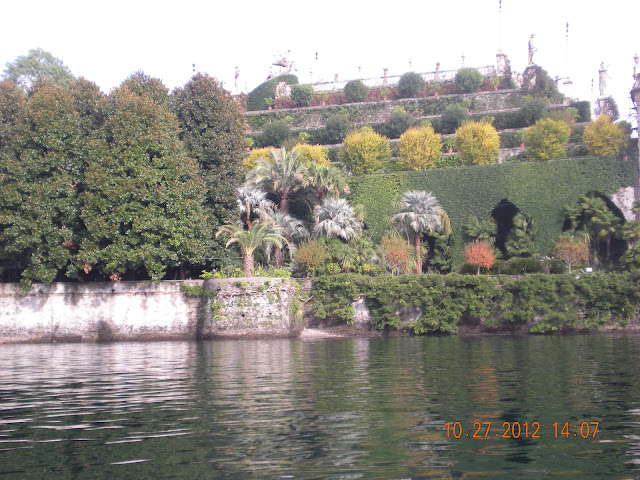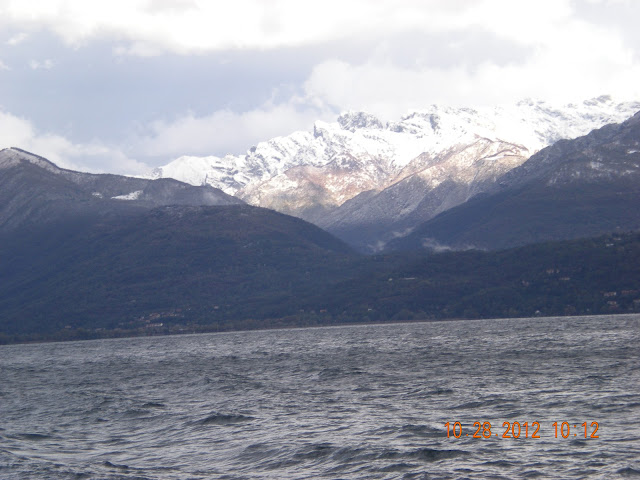We have taken a couple of train trips to Milan and the route passes through the town of Stresa, Italy. It is about a 2 1/2 hour train ride from Vevey. Stresa is located on the shore of Lake Maggiore, the 2nd largest lake in Italy. From the rail lines you can see three beautiful islands in the lake:Isola Bella, Isola Pescatori and Isola Madre. Every time we passed this way we kept telling ourselves we needed to schedule a visit. So, this last week end we scheduled a trip.
Stresa, located
in northern Italy, is a town of about 5,000 inhabitants on the
shores of the Lago (Lake) Maggiore. It is about 54 miles
northwest of Milan.
Stresa, which means (thin stretch) was named
for the original strip of fishermen’s huts that lined the shore. Since the
early 20th century, the main source of income has been the tourist trade. Like
other locations on Lake Maggiore, it benefits from spectacular views as well as
areas of historical and architectural interest.
A little history:
The name of the town first appeared in
documents in 988. In the 15th
century it grew into a fishing community and owed feudal allegiance to the Visconti
family. It subsequently came under the control of the Borromeo family.
The Borromeo family fled from Tuscany to Milan in 1395, where they bank-rolled the rise of the Visconti family, in the process, building a European financial empire. They bought the Arona fiefdom in 1447 (located on Lake Maggiore). They tackled the era's turbulent political winds, married wisely and associated with the Sforza family (who acquired Milan from the Visconti family), while slowly gaining control of Lake Maggiore and the islands.
The Borromeo family fled from Tuscany to Milan in 1395, where they bank-rolled the rise of the Visconti family, in the process, building a European financial empire. They bought the Arona fiefdom in 1447 (located on Lake Maggiore). They tackled the era's turbulent political winds, married wisely and associated with the Sforza family (who acquired Milan from the Visconti family), while slowly gaining control of Lake Maggiore and the islands.
For centuries Stresa has been a popular retreat
for Europe's aristocrats, who have endowed the town with a number of villas.
Tourism increased substantially after tunneling
of the Simplon Pass allowed train services from north of the Alps to pass
through Stresa in 1906.
A view of Isola Bella. It truly is a "Beautiful Island".
The island is situated about a 0.25 mile from Stresa. It is 1,050 ft. long
by 1,312 ft. wide and is entirely occupied by the Borromeo Palace and its
magnificent gardens.
Until 1632 the island was a rocky crag occupied
by a tiny fishing village: but that year Carlo Borromeo III, the 2nd cousin to Saint Carlo Borromeo, began the
construction of a palace dedicated to his wife, Isabella D'Adda, from whom the
island takes its name. The work
was interrupted around the middle of the century when Milan was struck by a
devastating outbreak of the plague.
Construction resumed when the island passed to
Carlo’s two sons, Giberto III and
Vitaliano VI, the latter in particular, with the financial backing of his elder
brother, entrusted the completion of the works to Carlo Fontana and turned the
villa into a place of sumptuous parties and theatrical events for the nobility
of Europe.
The completion of the gardens, however, was
left to his nephew Carlo IV. They were completed in 1671.
The Borromeo Palace.
The most famous member of the Borromeo family was Saint
Carlo de Medici Borromeo (1538-1584), who was the Archbishop of Milan, Italy
(1560-1584), the son of the Count of Arona Ghiberto Borromeo (1512-1558) and
Margarita de Medici, sister of Pope Pius IV (1559-1565). Saint Carlo was a
leading figure during the Counter-Reformation and was responsible for
significant reforms in the Catholic Church, including the founding of
seminaries for the education of priests.
He is honored as a saint in the Catholic Church and his feast day is
November 4th...same as Renee's.
The Borromeo family, of Milan, still owns Isola Bella and Isola Madre.
The Conference of Stresa was held in the Borromeo palace's Music Room in 1935, when Mussolini met with British and French diplomats in an attempt to scare Germany out of starting World War II; this "Stresa Front" soon fizzled when Mussolini attacked Ethiopia and later joined forces with Hitler.
 Because it was so late in the season, the gardens were not open to the public. However, from the next few pictures you get a sense of how magnificent they must be when in full bloom.
Because it was so late in the season, the gardens were not open to the public. However, from the next few pictures you get a sense of how magnificent they must be when in full bloom.A front view of the Borromeo Palace. As you can see by the umbrella that Paula is holding, it was not a great weather day.
One of the unique trees on the island.
A view of Isola Madre from Isola Bella.
Isola Madre (Mother Island) The island is situated 0.62 miles from
Stresa. It is 721 ft. long by 1,082 ft. wide. It is the largest of the Borromean Islands. It boasts a 20-acre park that is considered one of the most
impressive and well-preserved in Italy.
A view of Isola Pescatori.
Isola dei Pescatori (Fishermen’s Island) The island is situated 0.37 miles from
Stresa. It is 1,230 ft. long by 328 ft. wide. As the most northerly of the
three principal Borromean Islands,it is also known as Isola Superiore
and, with a population of 32, it is the only one to be inhabited all year
round. Unlike Isola Bella and Isola Madre, the island no longer belongs to the Borromean
family.
A narrow street running along its spine is
joined by cobbled alleys to the promenade which encircles the island. The
promenade is frequently flooded and the houses built against it are constructed
to allow for this.
While the traditional occupation of fishing
still exists—local restaurants providing a ready market for the fish—tourism
has become central to the economic life of the island as its picturesque charms
have made Isola dei Pescatori a popular destination.
The church of San Vittore ( St Victor the Moor) retains traces of an ancient chapel which was constructed for the monks of Scozzola, from the abbey of San Donato di Sesto Calende, founded by the Bishop of Pavia (a town near Milan), in the mid ninth century.
A view of the front entrance to the church.The main altar.
One of the side altars.
A picture of the town of Verbania, it is across the lake from Stresa.
A view of the Stresa waterfront. There are numerous large villas overlooking the waterfront and also dotting the hillsides overlooking the town.
Another view of the waterfront.
The Grand Hotel des Îles Borromées.
It was built in 1861 by four brothers; members of the Omarini family who owned the
Hotel Delfino on Isola Bella and after buying some land along the lakefront in
Stresa started work on the sumptuous hotel.
In 1918, nineteen year-old Ernest Hemingway was
wounded in Slovenia as an ambulance driver for the Italian Red Cross. He was taken to this hotel, which
served as an infirmary during Word War I.
In 1948 he returned to the hotel and stayed in the same room, #205 now
called the “Hemingway Suite”. You can stay in this room for two thousand dollars a night. In his 1929 novel “Farwell to Arms”, part of it is set in
this hotel.
Another famous guest was Winston Churchill, who honey-mooned here in 1909.
Our return from the island marked the end of the day. It was still early so we visited the old part of Stresa. The weather got real nasty, with heavy rain and wind, so we decided to sit at one of the covered bars to have an aperitif. The weather got even worse, as thunder and lighting moved in.
When we went to bed Saturday night we were still experiencing heavy rain and wind and the temperature was dropping. When we left our hotel Sunday morning, to go sight seeing, we discover that the mountains, which had been bare the day before, were now covered in a heavy blanket of snow. In fact, as we headed back to Vevey, some of the valley towns had 3" to 4" of snow.
The rain had subsided, though is was still very windy, so we decided to walk along this promenade that runs along most of Stresa's waterfront, offering
expansive views of the lake, islands and mountains.
During our walk we dodged white capped waves crashing over the sea wall.
In one of the Stresa parks, along the waterfront, is this statue honoring the Alpini troops.
The Alpini are the mountain troops of
the Italian Army, specialized
in the war on mountainous terrain.
Formed in 1872, the Alpini are the oldest
active mountain infantry corps in the world, originally created to protect the mountainous borders of northern Italy, France, Austria-Hungary and
Switzerland. In 1888 the Alpini
were sent on their first mission abroad, in Africa, a continent in which they went back to several times in their history, to fight colonial wars for the
Kingdom of Italy. They
distinguished themselves during World War I, when for three years; they had to
deal with the mountain troops of Austria and Germany, in what has since become
known as the “war at high altitude”.
During World War II, the Alpini fought
alongside Axis forces, mainly in the Balkans and on the Eastern front (also
known as the Russian campaign), where they suffered serious losses during the
defensive battle and the tragic retreat of the winter 1942-1943.
Due to reorganization of the Italian Army,
after the end of the Cold War in 1990, three of the five
Alpine brigades and many support units were disbanded. From 2003 to April 4,
2011 the Alpini were constantly engaged in Afghanistan.
Paula on the promenade with Isola Madre in the background.
A view of Isola Bella from the promenade. You can see how the wind is kicking up waves on the lake, which is normally quite calm.
During our walk, we discovered that next to The Grand Hotel des Îles Borromées is the Garden "Radura dei Pavoni", literally translated it means Glade of Peacocks.
In the garden are four statues (The Nymphaeum of Continents) that are copies of classics and represent the continents of Africa, America, Europe and Asia. Two are shown here and the other two are shown in the next picture.
On the stroke of the hour, it offers an enchanting surprise, the sweet melody of a carillon, which announces the beginning of the "jeux d'enu" (water games). For a few minutes, jets give life to all of the basins, in a crescendo of cheerful and joyful water movements. In the evening, a spectacular illumination follows the water movements in a vibrant, magic and charming atmosphere.
Thus, our visit to Stresa came to an end and we had to head back to freezing cold Vevey.
























No comments:
Post a Comment